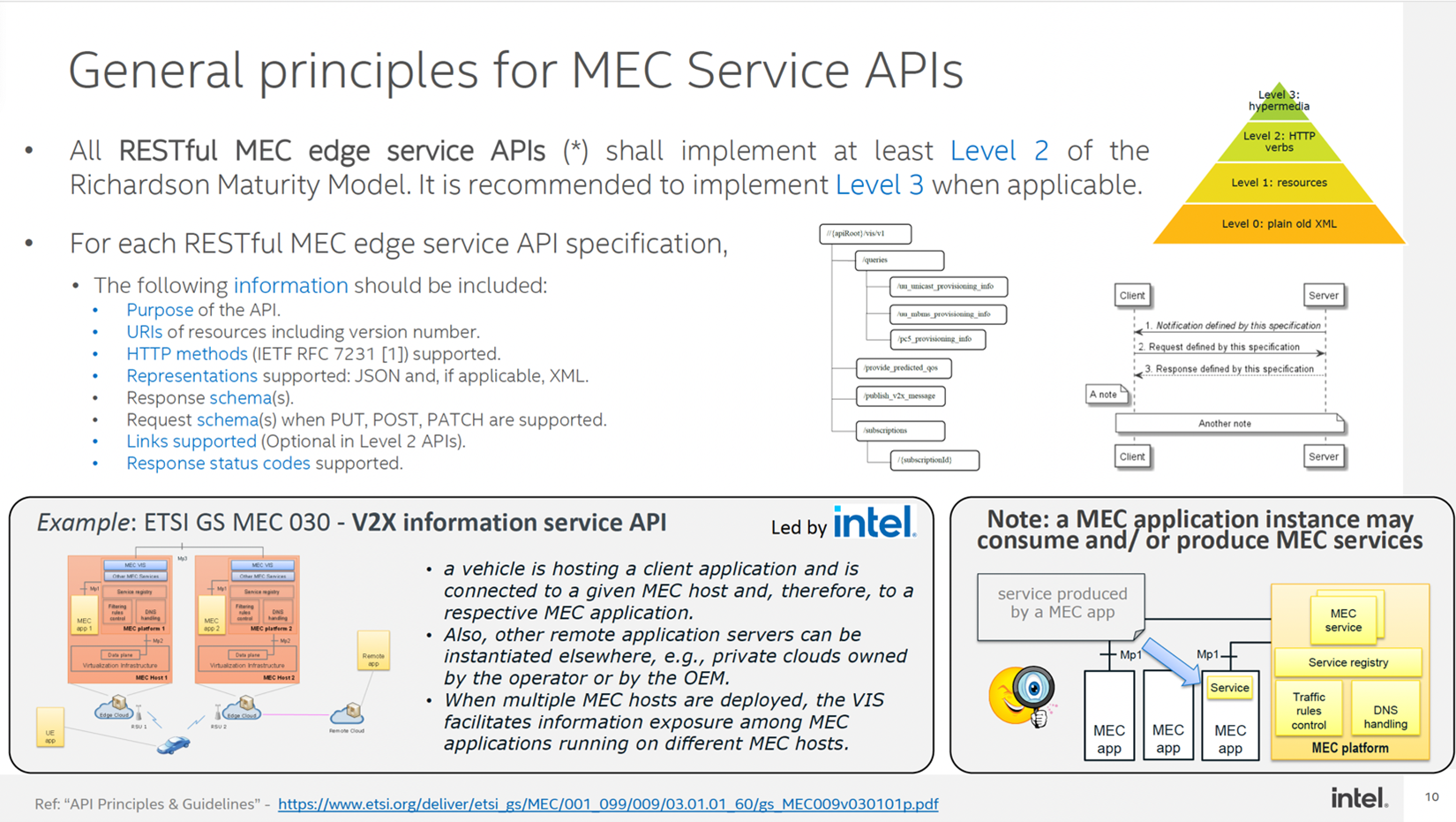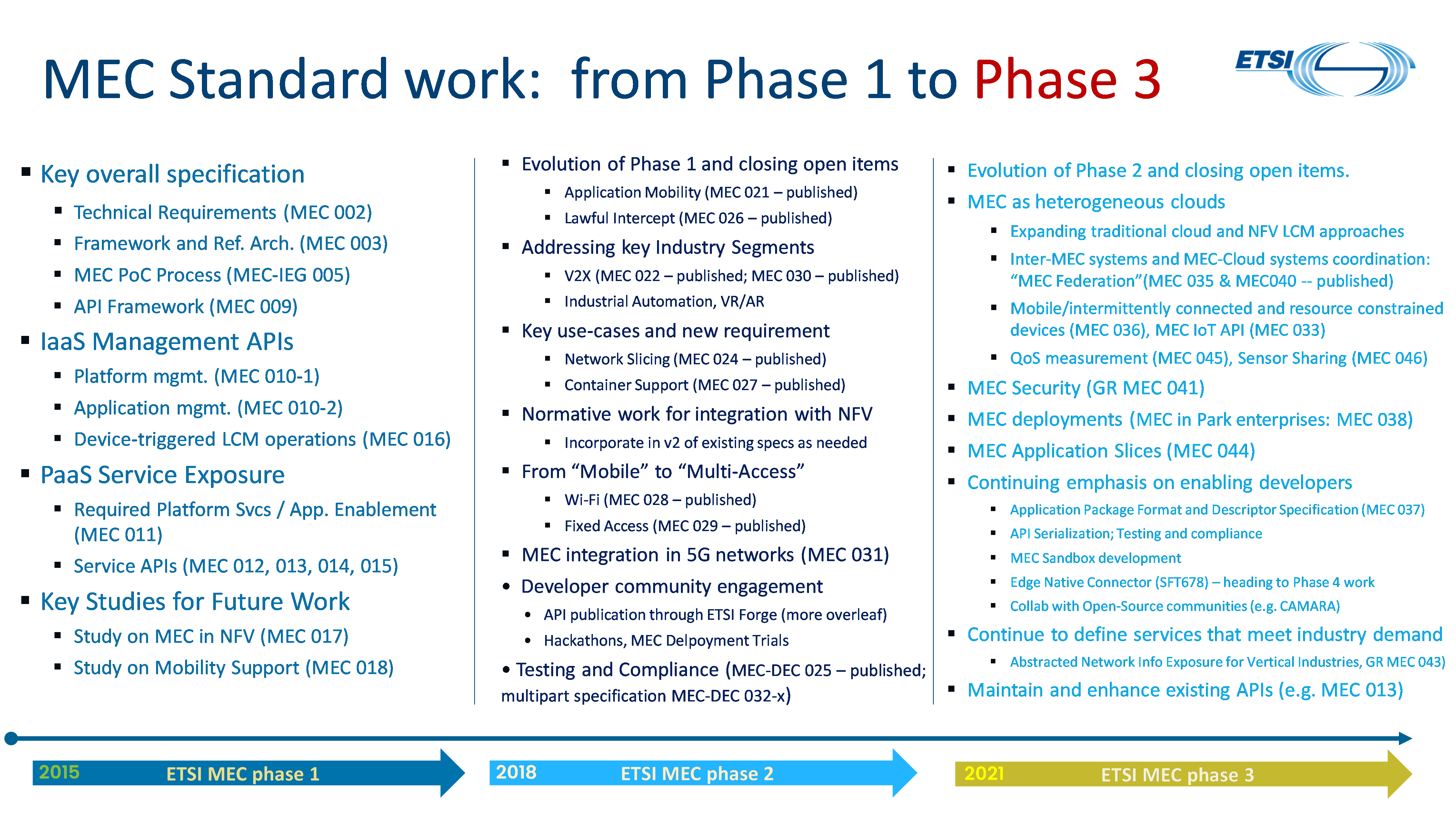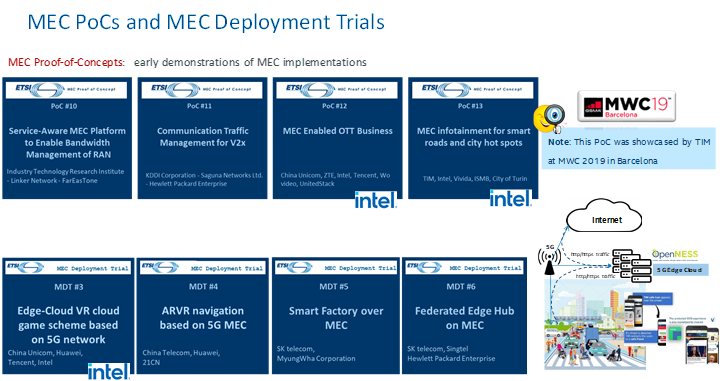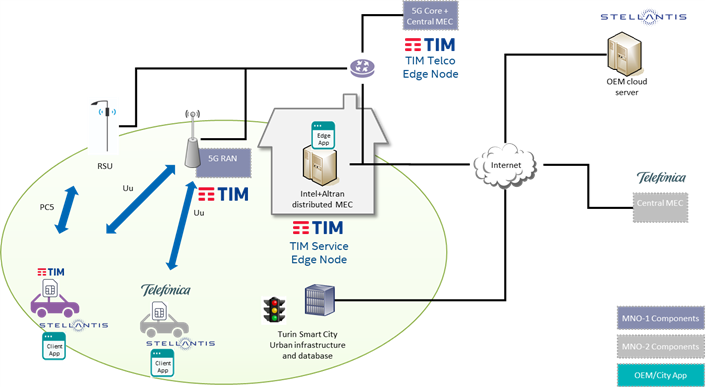While edge computing unlocks unprecedented value for businesses, it presents infrastructure owners, developers, and industry stakeholders with a set of unique challenges—particularly related to global interoperability and application portability that must be addressed by proper standardization. The multi-access edge computing (MEC) initiative, an Industry Specification Group (ISG) within the European Telecommunications Standards Institute (ETSI), is helping to create a standardized, open environment for interoperability across the edge ecosystem. This post provides an overview of MEC and recent Intel-led MEC trials that support edge infrastructure collaboration between operators and service providers.
The Motivation Behind MEC
The rise of the intelligent edge gives businesses the freedom to process workloads closer to endpoint devices, helping to reduce application latency and improve service capabilities. However, heterogeneous architectures required to power edge-based workloads also bring a trade-off in terms of scalability, cost, and performance.
Intel has a strong business motivation for helping customers bring scalability and cost efficiency to edge-native use cases. We offer silicon for data centers, which often need to support cellular infrastructure, edge nodes, roadside units (RSUs), and roadside infrastructure. Intel® products such as oneAPI, Intel Software Guard Extensions (Intel SGX), Intel Edge Platform and OpenVINO toolkit support edge-computing use cases. We also offer solutions for edge-based verticals, such as automotive and industrial automation.
Standardization is needed to achieve interoperability and global adoption across the edge market. Intel believes that edge-based tools should support open standards and align with industry needs.
Introducing ISG MEC
ETSI created the ISG MEC in 2014 with two goals: to improve edge infrastructure by enabling virtualization—in alignment with the work of ETSI ISG Network Functions Virtualisation (NFV)—and to address the needs of the MEC application development community. MEC standardizes a few industrially meaningful examples of MEC service application programming interfaces (APIs) as essential tools to expose functionalities at the edge for application developers. At the same time, ETSI MEC allows other API implementations, as long as they comply with the basic MEC principles for API design.
Given its acronym, MEC is focused not just on the mobile edge, but on multiple accesses, addressing edge computing standardization with an access-agnostic nature, whereas various access technologies, such as cellular, Wi-Fi, and fixed-network, are typically covered by groups such as 3GPP, Wi-Fi Alliance, and Broadband Forum. Beyond standards bodies, ETSI MEC is establishing partnerships with industry groups such as GSMA and 5GAA and open source groups like the CAMARA project, a Linux Foundation project. MEC membership is continuously growing—from 114 members in June 2021, to 127 in April 2023, and to 150 in January 2024. MEC is a heterogeneous ecosystem that includes both big and small companies, operators, technology providers, application developers, governments, and research institutions.
Helping Application Developers
In addition to enabling workloads to run at the edge, MEC also gives application developers cloud-computing capabilities and a complete IT service environment at the edge of the network. This improves performance by allowing companies to collect local data (from sensors, for example) and consume APIs locally at the edge.
To support developers, ETSI MEC is founded on a few key principles:
- Open standards: MEC allows multiple implementations, ensuring interoperability. MEC also open sources the OpenAPI representations of the published MEC service APIs.
- Network virtualization: MEC is helping others take advantage of virtualization. Based on the ETSI NFV framework and definitions, ETSI MEC is enabling MEC in NFV deployments. Additionally, MEC supports multiple virtualization technologies such as VMs and containers.
- 5G enablement: MEC is aligning with 3GPP to help operators enable MEC in 5G deployments.
- Access agnostic: MEC is not just focused on 5G, but supports many types of edge environments, including Wi-Fi and fixed access.
- Vertical agnostic: MEC is addressing the needs of a wide ecosystem, enabling solutions in multiple verticals.
Workflow in ETSI MEC
MEC’s standardization workflow typically looks like this:
- Study phase: When exploring a new topic, the work typically starts with a study, which is published in a group report (GR), to analyze gaps and recommendations before moving to normative work and publishing the actual standards.
- Normative work: Normative work targets the publication of globally applicable standards, such as MEC service APIs, in a group specification (GS).
- Open source representation: For each MEC service API published, ETSI publishes the related OpenAPI representations on ETSI Forge for use by the open source community.
- Testing and conformance: ETSI task forces help enable test suites in various machine-readable languages like Robot and TTCN-3, provide automated test suites in ETSI Forge, and support ETSI Plugtests events for interoperability testing.
- Real-world implementations: ETSI ensures standards are fed by real-world implementations, such as working code, open source projects, and products. Most MEC standards have started from implementations or are inspired by them throughout the entire workflow. Examples of MEC components from products or open source projects can be found on the MEC ecosystem page. Collaborative implementations involving multiple partners are given by MEC proofs of concepts (PoCs) or by MEC Deployment Trials (MDTs), often involving multiple operators. All these proofs of MEC implementations are available under the MEC Wiki.
General Principles for MEC Service APIs
As default application transport protocol, MEC service APIs are based on HTTP-REST to enable a universally recognized language at the application level. MEC also supports additional transports, such as MQTT, Apache Kafka, and gRPC. The MEC work consists of defining the API and its resource tree—including all the elements, data types, and attributes—as well as the messaging needed and related response codes for the entire product definition. Read more about the MEC and RESTful principles here.
As an example, V2X Information Services API, a work item led by Intel, was published in 2023 in the ETSI GS MEC 030 specification. Remarkably, the phase 3 version of this specification was contributed to substantially by 5GAA, with inputs from association stakeholders such as carmakers, Tier 1 suppliers, and technology providers.
Another example of MEC service API is the ETSI GS MEC 015, focused on MEC Traffic Management APIs. Intel led the development and open sourcing of this generic multi-access technology based on the multi-access traffic management framework.
To support collaboration, a MEC service API can be produced by the MEC platform itself or by a MEC application. While many APIs are standardized by ETSI, the goal of MEC is not to standardize everything. New MEC APIs can be added to the platform as a service for other applications to use, enabling MEC to be used as a middleware to serve higher-level applications and third parties and creating even more market opportunities for Intel partners, customers, and the entire ecosystem.

MEC services can be made available on the platform for other applications to consume.
The Specification Road Map
Let’s look at a quick overview of the MEC standardization road map, which takes place in phases lasting three years each. MEC Phase 1 work (2015‒2017) established the Infrastructure as a Service (IaaS) and Platform as a Service definitions and first specifications. MEC Phase 2 (2018‒2020) added new APIs; clarified MEC in NFV deployments, including how to integrate MEC into 5G, Wi-Fi, and fixed networks; and started testing and compliance activities. MEC Phase 3 (2021‒2023) expanded the scope into the multicloud domain and cloud system communications; started the work on MEC security, MEC enterprise deployments, and MEC application slices; and added new APIs, (e.g. Sensor Sharing API, QoS measurement API, Enablement API for Customer Self-Service), while maintaining existing APIs.

Key MEC activities by phases.
In MEC Phase 4 (2024‒2026), the ETSI group plans to move forward in support of future communication and computation systems, namely 6G. While no one can yet claim what exactly 6G will be at the time of writing this post, MEC is pragmatically starting from the vision to support the design of edge native applications—which you can read about the ETSI white paper (June 2023)—always with the aim to address the needs of application developers. To advance these goals, MEC Phase 4 will likely include the following:
- More-consolidated work on MEC federation, including exposure of resources managed by multiple operators, such as addressing multidomain and multitenancy slicing and MEC support for application slicing
- MEC architectural and service updates needed to support cloud-native communication systems and edge-native design for app developers
- Introduction of proper normative work to improve MEC systems security and privacy
- Further promotion of MEC as an attractive development environment for the industry by creating developer-friendly environments—such as portals and development kits—that enable convergence of application developers and operators
- Further outreach efforts, such as hackathons and trials, to strengthen collaboration with open source communities and industry groups like 5GAA
In order to further support developers and the design of edge native applications, ETSI already approved the creation of a Special Task Force STF678 on “Edge Native Connector” that will deliver in Phase 4 an edge application development experimentation environment, based on the cross-organisation harmonisation efforts that have been led by ETSI MEC, in alignment with other standards and industry groups (e.g. 3GPP EDGEAPP, GSMA OPG, CAMARA, 5GAA, ...).
MEC Deployment and Ecosystem Engagement Activities
Beyond the specification work, ETSI MEC supports the ecosystem through a few key activities. On the MEC Wiki page, ETSI publishes examples of MEC implementations and deployment trials and provides proofs of concept on the website and the MEC Sandbox for developers. ETSI MEC is also collaborating with Linux Foundation Edge project Akraino on the definition of open infrastructure blueprints that can use MEC specifications, including automotive use cases such as MEC-based stable topology prediction for vehicular networks, mixed and augmented reality use cases such as virtual classrooms, and edge computing and 5G use cases such as enterprise applications on lightweight 5G telco edge (EALT-EDGE).
Additionally, MEC Hackathons and Plugtests encourage developers to get involved. In MEC Hackathons, application developers compete at the edge. They’re often organized as co-located with big conferences and events, in collaboration with open source communities like the Linux Foundation and recently industry groups like 5GAA. The goal of MEC Hackathons is to encourage developers to use MEC technologies and APIs and design applications that show the benefits. For this purpose, ETSI is offering free use of the MEC Sandbox, an interactive software environment that enables users to learn and experiment with ETSI MEC service APIs. Intel contributes to hackathons by helping organize the event and providing hardware and software to teams. Hackathons are thus key initiatives to engage the software development communities and show them how MEC can help them build new services.
The group also created the MEC Tech Series, a series of podcast episodes and short YouTube tutorials (available in slide format here), designed to explain implementation issues around specific parts of the MEC standards to a wider audience.

Example proofs of concept and deployment trials, including a MEC infotainment implementation for 5G edge that was showcased at the 2019 Mobile World Congress.
Automotive Use Cases
Within the 5GAA framework, Intel led a joint collaboration with other companies to create a live demo in 2019 showing how MEC can support immersive, high-definition vehicle infotainment for all occupants, including video streaming, gaming, virtual reality, office and school work, and advertisements. The showcase also included a demonstration of the benefits of edge computing by comparing different deployment options and the possibility of using predictive Quality of Service (QoS) to improve multimedia delivery adaptation.
In 2022, Intel led two live multi-operator MEC trials—in Turin, Italy, and Blacksburg, Virginia—to demonstrate vehicle safety technologies that use MEC and 5G live networks to alert drivers of roadway hazards in real time. The trials showed that typical use cases for connected and automated cars are possible, both in operator MEC setups and in roaming scenarios instead of a neutral host, including with various scenarios such as national roaming. Built on Intel® infrastructure, the trials instantiated similar MEC systems in multiple mobile network operator (MNO) environments, where the hosting operator provided the radio access, enabling local connectivity with the devices and vehicles in the city. Read more about the trials here.

A high-level look at the system architecture of the MEC trial in Turin, Italy.
Apart from Intel, other technology providers have led creation of MEC trials, helping to foster the understanding of practical deployment issues in these complex environments and helping to kick off the MEC market. These trials include connected safety notification technologies from Stellantis, a collision warning solution from Deutsche Telekom and Telefónica, and a cloud gaming trial from SK Telecom and Singtel.
The Path to Standardization
These trials helped to advance standardization work by connecting different MEC systems via East/West Bound Interface (EWBI), which enables multiple-operator federation and allows developers to deploy their workloads across all federated domains. The requirements coming from GSMA on federation led to a set of complementary activities alongside open source projects like CAMARA and relevant standards bodies ETSI, MEC, and 3GPP, helping to enable globally interoperable MEC deployments. In this perspective, the latest advancements from MEC Phase 3 and 3GPP Release 18 have produced strong alignment on edge computing standards, including support of MEC federation.
Get Involved in MEC
As an international standard body with a growing heterogeneous ecosystem of stakeholders, ETSI MEC is collaborating with other standards, open source projects, and industry groups to drive edge computing standardization and support developer needs. To continue to enable global interoperability at the edge, the MEC ecosystem is fostering collaboration among all kinds of stakeholders, from infrastructure owners (not just telcos) to app developers and the open source communities. To get involved in MEC, contact ISG support.
You can learn more via the following links:
- The MEC website includes specifications, meetings, events, and related news.
- The ETSI MEC standards portal has more-technical information for MEC standard delegates.
- The MEC Wiki includes information and resources for PoCs, MEC Deployment Trials, Hackathons, and more.
- The list of MEC members and participants is updated regularly.
- The MEC leadership page has a list of MEC leaders, LS officers, and support team.
- The MEC overview slides are updated on a quarterly basis, after each MEC plenary meeting.
- MEC deliverables page features all published deliverables, including both GSs and GRs.
- ETSI site includes white papers as solution-driven complementary material to standards.
- ETSI Forge includes OpenAPI representations of MEC APIs.
- The MEC Tech Series has insights and tutorials via videos, podcasts, and presentations.
About the Author
Dario Sabella, Intel
As an Intel senior manager of Standards and Research, Dario Sabella works to drive new technologies and edge cloud innovation for advanced systems toward 6G, including managing ecosystem engagement and coordinating alignment on edge computing across standards and industry groups. In February 2021, Dario was elected as the chair of ETSI MEC. Previously, he was MEC vice president and lead of Industry Groups and the vice chair of IEG WG. He has also been a delegate of 5GAA since 2017.
Before 2017, he worked at TIM, where he was responsible for various research, experimental, and operational activities on OFDMA technologies such as WiMAX, LTE, and 5G. Dario is the author of more than 80 publications and more than 50 patents in the field of wireless communications, energy efficiency, and edge computing. Dario is an IEEE senior member and senior associate editor on the editorial board of IEEE Consumer Electronics Magazine and has also organized several international workshops and conferences.
